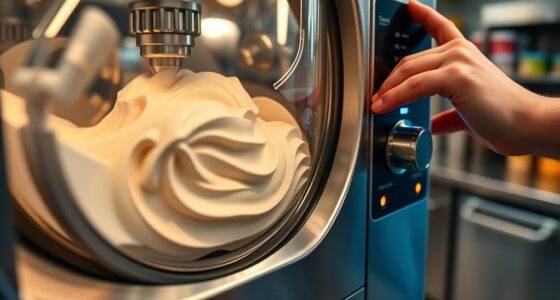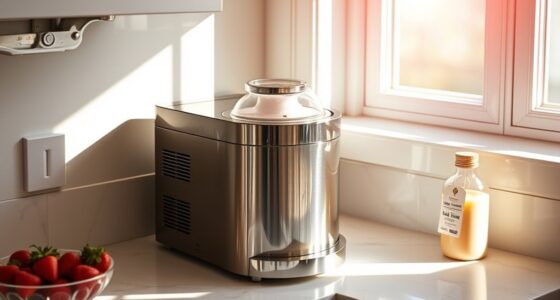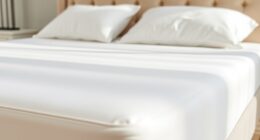Whirlpool-style mixers create a gentle, swirling motion that produces lighter, fluffier textures, making them perfect for whipping cream or egg whites. Paddle-style mixers offer more direct contact, ideal for thick batters and kneading dough, providing more control and thorough mixing. Your choice impacts your baked goods’ texture, whether airy or dense. Want to discover which type best suits your baking style? Keep exploring to find out more.
Key Takeaways
- Whirlpool mixers create a gentle swirling motion ideal for airy, light textures like whipped cream and egg whites.
- Paddle mixers provide direct contact, delivering thorough mixing suited for dense batters and doughs.
- Whirlpool models excel at incorporating air, resulting in fluffier, lighter baked goods.
- Paddle-style mixers develop gluten better, producing firmer textures in bread and pizza dough.
- Choice of mixer influences final texture: whirlpools for delicate mixtures, paddles for dense, heavy doughs.

When choosing a stand mixer, understanding the differences between whirlpool-style and paddle-style models can help you make an informed decision. Each type offers unique advantages that influence how well they perform specific baking techniques and affect dough consistency. The choice ultimately depends on what you prioritize in your baking process, whether it’s speed, texture, or versatility.
Whirlpool-style mixers typically feature a rotating bowl with a fixed beater or whip. This design creates a gentle, swirling motion that’s excellent for delicate tasks like whipping cream or beating egg whites. When it comes to baking technique, whirlpool models excel at incorporating air into ingredients, resulting in lighter, fluffier textures. However, they might not be the best choice for kneading dense doughs, as their motion isn’t as aggressive or thorough in developing gluten. For recipes requiring a specific dough consistency—like bread or pizza dough—you might find that whirlpool mixers don’t provide the same level of control and uniformity as paddle models.
On the other hand, paddle-style mixers, also known as flat beater models, feature a stationary bowl with a rotating paddle. This setup is particularly effective for mixing thicker batters and kneading dough, giving you more control over the texture. The paddle’s direct contact with ingredients allows for more thorough mixing, ensuring that ingredients are evenly distributed and that the dough reaches the desired consistency. If you’re working with bread dough, cookie dough, or heavy mixtures, paddle-style mixers tend to perform better because they generate the necessary force and agitation to develop the proper dough consistency. They’re also versatile enough to handle a variety of baking techniques, from creaming butter and sugar to mixing dense batters.
While whirlpool models are gentle and suited for light, airy mixtures, paddle-style mixers deliver the power needed for more intensive tasks. If your baking involves a lot of bread or cookie recipes, a paddle-style mixer may become your go-to because of its ability to produce consistent results. Conversely, if you primarily focus on whipping lighter ingredients or delicate mixtures, a whirlpool-style could suffice, but it might fall short when tackling more substantial doughs. Choosing between the two ultimately hinges on your baking needs—consider how each model’s motion and design influence the dough consistency you aim for and the techniques you want to master. Additionally, motor power plays a significant role in how effectively each type can handle various mixing tasks, especially with thicker doughs.
Frequently Asked Questions
Which Mixer Type Is Easier to Clean?
When considering ease of cleaning, paddle-style mixers often have the edge because their removable beaters can be easily washed by hand or in a dishwasher. Whirlpool-style mixers tend to have more complex attachments and surfaces that may require more maintenance. If you want to minimize cleaning time and effort, a paddle-style mixer is generally simpler to maintain, making it a more convenient choice for busy kitchens.
Do Both Mixers Handle Gluten-Free Dough Equally Well?
Both mixers can handle gluten-free dough, but your experience depends on mixer performance. Whirlpool-style mixers tend to provide more consistent kneading, ensuring your gluten-free dough develops properly without overworking. Paddle-style mixers are often gentler, which may help preserve delicate textures. If you frequently make gluten-free bread, investing in a mixer with strong performance and adjustable speed settings will give you the best results and easier handling.
Are There Differences in Noise Levels Between the Mixers?
When comparing noise levels, you’ll notice differences in sound levels during operation. The noise comparison shows that Whirlpool-style mixers tend to operate more quietly, thanks to their design, while paddle-style mixers might produce louder sounds, especially at higher speeds. You’ll appreciate the quieter performance if you prefer a less disruptive kitchen environment. Overall, considering sound levels can help you choose a mixer that fits your comfort and convenience needs.
Which Mixer Type Is More Energy-Efficient?
You might wonder which mixer type is more energy-efficient. Generally, paddle-style mixers tend to have lower energy consumption because they use less power to operate, making them more power-efficient for typical tasks. Whirlpool-style mixers often have higher energy use due to their more powerful motors. When choosing, consider your needs for power efficiency to save energy and reduce utility costs, especially if you use your mixer frequently.
Can Both Mixer Styles Be Used for Commercial Baking?
Imagine you’re in a bustling bakery, and your mixer’s got to handle heavy-duty tasks. Both whirlpool-style and paddle-style mixers can be used for commercial baking, but they differ in dough consistency and mixing speed. Whirlpool-style mixers excel with thick doughs, offering powerful mixing, while paddle styles provide versatility for lighter tasks. Choose based on your needs, knowing both are capable, but not always equally efficient for every commercial application.
Conclusion
In the end, choosing between whirlpool-style and paddle-style mixers boils down to your specific needs. If you want smooth, airy textures, a whirlpool mixer might be your best bet. But if you prefer versatility and control, a paddle mixer could be the way to go. Remember, sometimes you have to roll with the punches and adapt to what works best for you. Whichever you pick, trust that you’ll be able to whip up great results.









